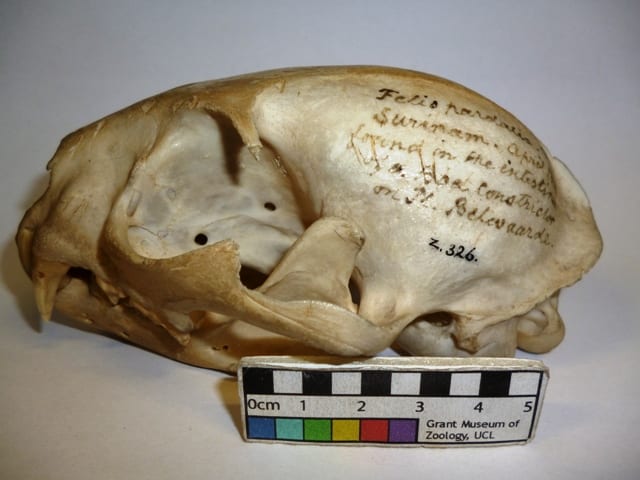From the vollies: Loose ends and key information
By Mark Carnall, on 31 October 2013
This is a guest blog from one of the Grant Museum’s volunteers, Geoffrey Waller. Geoffrey has been volunteering for the Museum for a number of years undertaking the diligent collections care work that helps us to function as a museum and make the most of our collections here. Recently, Geoffrey has been going through one of our many series of card indices cross-referencing information with our current catalogue, enriching data we have about our specimens which make them significantly more useful for teaching and research. Here are some of the highlights.
For the last 18 months I have been working on a long-term cataloguing project at the Grant Museum. The project has involved sorting a large collection of some 1500 hand-written record cards into appropriate categories and numerical order. Each card (known technically as an MDA card*) bears the specimen’s accession number – the unique identifying number given to specimens on the Grant Museum collections database. It is therefore possible to cross-check the specimen data on the MDA card with the data already held on the database.
Mining the Data
During this cross-checking, I could add any new information recorded on the MDA cards to the existing database entries, making it available to anyone accessing the records. This highlights one of the frustrations of working with a university collection. Often crucial data exist somewhere in the archives, but each part of the archive has specific information about specimens that for whatever reason (mistranscription, human error, newer documentation initatives) hasn’t been synthesised into the collection catalogue. As each MDA card typically has numerous data fields printed on both sides of the card arranged in a fixed format, it has been a time consuming task to examine each field in turn and then transcribe, where relevant, the hand-written information about the specimen to the appropriate section of the database.
The MDA card is designed to provide the maximum information in the minimum of space. The nature of the specimen (skeleton, fossil, fluid preserved etc.), its scientific name, sex and age, collection date and place, acquisition and conservation method are among the numerous data fields available for each specimen. Oddly, some specimens have multiple cards with different or conflicting information and working out the true story has required detective work, lateral thinking and often a parsimonious solution.

The history of this ocelot specimen is recorded directly on the skull and reads “Felis pardalis. ♀ Surinam. April 1888 found in the intestines of a Boa constrictor on JL. Belwaarde.”
It’s all just a little bit of History repeating
Historically, the MDA cards were the third attempt to catalogue the Grant Museum collections and date mainly from the 1980s. The first catalogue of the collection was published by E.Ray Lankester in 1891 but appears to be part catalogue, part wishlist. The next attempt was a card index series that was started in the early 1900s and continued up until the 1970s.
To confuse things each of these initiatives started from scratch rather than continued on from each other. This means that there’s at least three places to check for information relating to the history of any specimen until, like this MDA series, they are reconciled with our current catalogue. The 1980s series covers much of the animal kingdom from sponges to humans. However, as ever, priority seems to have been given to the vertebrates, the fossil fishes and living mammals, between them account for over two-thirds of the total MDA cards examined.
Many of the fossil fishes were found to belong to the genus Millerosteus, Devonian placoderms from Scottish fossil beds. This is a very important collection of underwhelming fossil fish, collected by D.M.S Watson and, in addition to others, studied by one Adrian Desmond for his UCL Masters thesis in 1973.
Discovering the origins of the collection
Some of the cards record important provenance information such as specimens which came from London Zoo and specimens which were donated from other museums and researchers. This information is crucial for using specimens in research as often we want to isolate captive animals when looking for data about wild populations. From the MDA cards, it was discovered that a number of specimens had been figured in journal articles – more important information for the collections catalogue.

Image of rodents with abnormal tooth growth. Note also the curious and poignant label on the left “Remember Glis glis.”
Curiously, there were several instances where the skin and skeleton evidently belonging to the same animal were catalogued separately and the relationship of skin to skeleton was only recorded on this card series and nowhere else. There was also the occasional surprising and unexpected result; for example, one of the Grant Museum’s ocelot specimens (image above) was recorded on its MDA card as coming from an extraordinary provenance – in the gut of a boa constrictor!
Unusual pathology and abnormalities were also detailed including rodents with hypertrophied (over enlarged teeth often curling back into the skull of the animal) dentition (and curious labels). Specimen preparation methods listed on the MDA cards such as vinagel squeeze, crystablic embedding and weyline cast are important and were recorded at the time the cards were written. However the exact nature of these methods, how they affect specimen dimensions and preservation and how they were used in the Grant Museum is not recorded and one avenue of futher exploration.
Geoffrey Waller is a volunteer at the Grant Museum of Zoology
Mark Carnall is the Curator of the Grant Museum of Zoology
*Museum Documentation Association card. The Museum Documentation Association founded in 1970 produced a range of templates and initiatives for documenting museum collections. It is now the Collections Trust an independent charity promoting management and use of collections and technology in museums, libraries and archives.
 Close
Close


